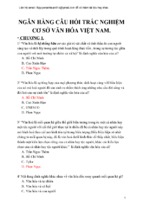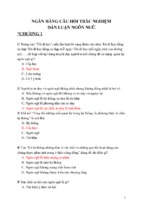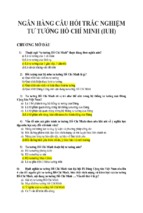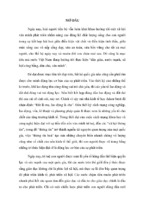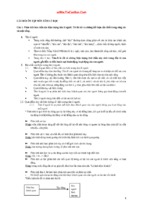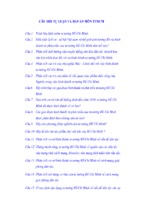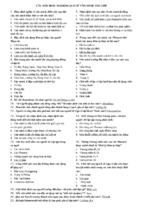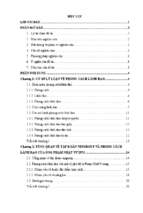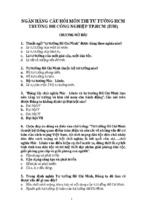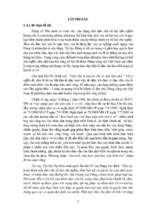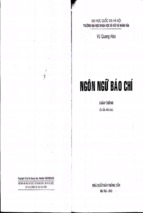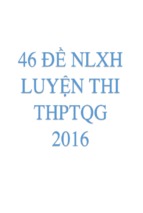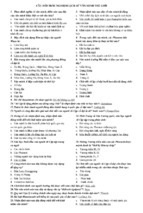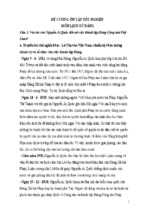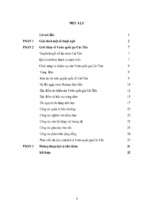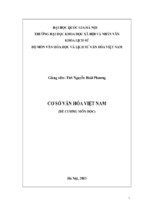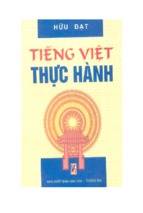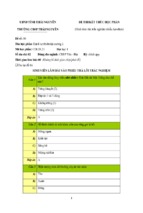MINISTRY OF EDUCATION AND TRAINING
HANOI NATIONAL UNIVERSITY OF EDUCATION
HO THI HONG VAN
TEACHING GRADE 10 BIOLOGY TO MEET THE
TARGETING OF CAREER ORIENTATION
Major: Theory and Method of Teaching Biology
Code:
9140111
DISERTATION SUMMARY FOR
DOCTOR OF PHILOSOPHY PROGRAM IN EDUCATION
Hanoi – 2020
The thesis has been completed at:
Faculty of Biology – Hanoi National University of Education
Supervisor: Professor Dinh Quang Bao
Reviewer 1: Associate. Professor. Mai Van Hung
University of Education, Vietnam
University, Hanoi
National
Reviewer 2: Associate. Professor. Nguyen Van Hien
Hanoi National University of Education
Reviewer 3: PhD. Le Thanh Oai
Journal of Education
The dissertation is defended before Scoring Board Council at
institution level at Hanoi National University of Education
at …. hour…… day….. month……. Year
The dissertation can be referred at:
1. National Library of Vietnam
2. Library of Hanoi National University of Education
1
INTRODUCTION
1. THE REASON TO CHOOSE THE RESEARCH TOPIC
Based on the need for educational innovation to meet careeroriented goals, the role of career orientation in the field of Biology,
and the role of the application of biological sciences in the field of
industry, in order to meet the career-oriented goals of the high school
Education Program and in teaching high school Biology, there should
be detemined how to select appropriate contents and organizational
methods with modern biotechnology processes that help students gain
specialized competencies in the subject and approach relevant career
options. Based on the analysis of the role, situation, guidelines of the
students’ career orientation, we have chosen the research topic
"Teaching grade 10 Biology to meet the targeting of career
orientation ".
2. RESEARCH PURPOSES
Establish a scientific basis and propose a process of organizing
the teaching of grade 10 Biology to meet the career-oriented goals in
implementing the General Education Program 2018.
3. STUDY OBJECTTIVES AND STUDY SUBJECTS
3.1. Study objectives
The process of teaching Biology meets the objectives of career
orientation for high school students.
3.2. Study subjects
The process of teaching and learning Biology meets the careeroriented goals for high school students
4. SCIENTIFIC HYPOTHESIS
If the principles are identified, the process of organizing the
teaching of grade 10 Biology with exploratory teaching is based on
the 5E inquiry learning model and experiential teaching to enhance
2
students' attitudes about science and technology applications and
interests , interested in the subject will contribute to the formation and
development of career-oriented capacity related to biology for
students.
5. RESEARCH TASKS
5.1 Identify theoretical basis for career orientation, career
orientation competence and teaching methods to develop students’
career orientation.
5.2. Surveying the reality of teaching Grade 10 Biology towards
developing career-oriented competencies in some high schools.
5.3. Analyze the content of Grade 10 Biology program, identify
contents that can be career-oriented for students.
5.4. Proposing principles, operational design processes, teaching
organizing process in Grade 10 Biology to form and develop career
orientation in students.
5.5. Develop career-oriented learning topics in teaching grade 10
Biology.
5.6. Develop criteria and tools for evaluating vocational
orientation competencies.
5.7. Pedagogical experiment to evaluate the achievement of
students' career-oriented competence through the process of teaching
grade 10 Biology.
6. RESEARCH LIMITATIONS
We chose to survey and study the methods of organizing teaching
some contents in the 10 high school biology program under the State
University. Subjects conducting surveys and experiments in grade 10
of some high schools.
7. RESEARCH METHODS
3
Theoretical research method, practical research method, expert
consultation method, pedagogical experiment method, mathematical
statistical method.
8. NEW CONTRIBUTIONS OF THE STUDY
- Systematize theoretical basis for career orientation, career orientation
capacity.
- Identify the structure of career orientation competence of high school
students
- Develop a design process and process for organizing 5E discovery
learning activities and experiential activities for career orientation in
Biology teaching.
- Identify criteria and tools to assess career-oriented competence in
teaching Biology.
[
RESEARCH RESULTS
CHAPTER 1: THEORETICAL AND PRACTICAL BASIS OF
TEACHING OF STUDENTS GRADE 10 BIOLOGY TO MEET
THE TARGETING OF CAREER ORIENTATIONS
1.1. Overview of research on career orienation and teaching
subjects to career orientation
Career orientation has been around for a long time in the world,
studies have affirmed the role of vocational training for young people
and students to help them choose a career that suits their ability,
interests, interested, encouraged to combine career guidance in
schools with production workers, visiting, practicing in factories to
enhance students' awareness of the career.
Through research on career orientation in the field of science and
technology in the world through the subjects for students, we realize
that this job is usually not carried out individually in a subject but has
4
integrated application. knowledge of many subjects, especially science
subjects. The authors have focused on studying the influence of
individual factors and the academic environment of academic subjects
on career choice of STEM. Career-oriented research for students
through the subject has been interested by some authors. However,
there has been no research on specific ways to design and organize
teaching activities to guide careers for students in teaching Grade 10
Biology under the new General Education Program (Ministry of
Education and Training, 2018).
1.2 Theoretical basis of teaching for career orientation at high
schools.
1.2.1. Perspective on career orientation at high school level
1.2.1.1. Career orientation
From analysis of research, in education, career orientation for
students is understood as a system of impact measures to guide and
prepare students to participate in labor in sectors of society based on
capacity, interest of the people.
Career orientation through Grade 10 Biology is a system of
impact measures of Biological teachers to guide and prepare students
to identify and select related careers, based on competence and
inspiration. your pets.
1.2.2.2. Some basic theoretical models of career orientation for
students
Analyzing some model such as: Eccles’ expectancy–value theory
(2009), Holand’s code (RIEAC), Krumboltz’s theory... are the
theoretical basis for teaching career orientation.
1.2.2.3. Psychophysiological characteristics and career awareness of
high school students
1.2.2.4. Characteristics and career-oriented goals in the General
Education Program and Biology Program 2018
The Biology program 2018 has a clear orientation of teaching the
basic content and is associated with practical applications,
5
technological processes related to biological professions to develop
the orientation. Career guidance for students. Biology grade 10 has
content circuits developed in the direction of basic biological content,
requiring students to apply in real life, application in technological
processes in fields related to biology (food technology, medicine,
agriculture, ...). This is a opportunity to organize teaching with the
goal of career orientation for students through this subject.
1.2.2. Career orientation competence
1.2.2.1. Concept of career-oriented competence
In this study, we will analyze career-oriented competencies based
on the definition of career-oriented competencies as follows: careeroriented competence is the ability to self-awareness about the interests
and strengths, cognitive ability, and planning to meet an individual's
career goals.
1.2.2.2. Expression of competence career orientation
Based on analyzing the views on the career-oriented competence of
the authors and based on the characteristics of Vietnamese education, we
selected typical characteristics of career-oriented competence as follows:
Table 1.1. Career orientation competence
Elements
Expression
- Determine your interests and abilities.
1. Skills for - Demonstrate an understanding of personal
characteristics related to achieving personal
awareness of
career goals
hobbies and
interests
of - Determine your desires, dreams, goals and use
yourself
for career guidance for a lifetime
- Identify the core knowledge of the subject
2. Awareness
- Identify and explain the relationship between
skills
on
academic content and practical applications in
application of
industry fields.
relevant
- Analyze job information, agencies and enterprises
subject and
and use this knowledge for future career and job
career
knowledge
selection.
6
- Determining learning goals related to career
choice for yourself
3.Career
- Determining expected career priorities
planning
- Identify measures to develop occupational skills
skills
(volunteering, extracurricular activities, part-time
work, transition programs from school to work,
etc.)
- Develop a personal career plan
1.2.3. Active teaching methods contribute to meeting career-oriented
goals in the field of science for students
Based on the previous research results and advantages in meeting
the goal of career orientation, we choose to organize exploral activities
(under the 5E Inquiry Learning Model) and teach experience to
organize teaching activities to discover science applications and career
experiences to improve the career-oriented competence for students
through grade 10 Biology. These teaching methods will be used in
teaching Biology, designed, organized and test the effectiveness of
increasing the interest in the subject and promoting students' learning
and career aspirations related to Biology on the basis of the theoretical
model of expected value of Eccles (2009). Our research model is
shown in Figure 1.5.
Experiential
activities
Student’s science interest
Student’s ultility
of science and
career awareness
5E Inquiry
Learning and
teaching model
Student’s career
planning
Figure 1.5. Research model
Student’s career
aspiration
7
5E Inquiry Learning Model
Model 5E (short for words: Engage, Explore, Explain, Elaborate,
and Evaluate. Applied quite popular in science classes and STEM
integrated programs in the US. The 5E Inquiry Learning model is
based on cognitive constructivism of the learning process, whereby
students build new knowledge based on knowledge or experience.
Experimental teaching model of David Kolb: consists of four
stages: (1) Concrete experience, (2) Reflective observation (3)
Abstract conceptualisation: (4) Active Experimetation.
The basis for designing 5E inquiry activities and career experiential
activities
Career
orientation
competence
(Objectives)
Developing
career-oriented
competence
The
component
skills
Developing the
component
competencies
Learning
activities
exploring
scientific
applications
Students perform
learning
activities
Designing
topics
based on teaching 5E
model,
teaching
experiential activities
Organize learning
activities
The basis for using 5E model and experiential teaching to develop career-oriented
competence
Figure 1.6. The basis for designing and organizing 5E discovery teaching
and experiential teaching activities for University of Foreign Studies for
students
1.2.4. Opportunities to develop career-oriented competence when
organizing discovery teaching under the 5E model and experiential
teaching
1.2.4.1. The relationship between teaching discovery under the 5E
model and the goal of developing career-oriented competencies
Exploration teaching in 5E model has many opportunities for
teachers to practice vocational orientation competencies for students,
8
this relationship is shown at each stage of the teaching model.
1.2.4.2. Opportunities to develop career-oriented competence when
organizing experiential teaching
Experiential teaching is a teaching method that has a positive
impact on raising interest in the subject, thereby contributing to the
development of career-oriented competencies for students. The
correlation between the characteristics of experiential teaching and the
corresponding manifestations of vocational orientation competencies
is shown at each specific stage of the experience cycle.
1.2.5. Assessment tool for career orientation
We have studied and applied flexibly the tools that have been
tested in the studies of Novodvorsky (1993), Ornstein (2005), PISA
(2015) to develop a scale to assess the career-oriented competencies of
Students in teaching Biology.
1.3. Current situation of career-oriented education in Vietnamese
schools
We investigated over 235 Biology teachers at some high schools
in Hanoi, Nam Dinh, Hoa Binh, Vinh Phuc and Lao Cai province and
319 students of some High Schools in Hanoi about the content, degree
of implementation and effectiveness of teaching and learning activities
aimed at career-oriented education, students' awareness of interests,
interests and access to career information through teaching students
study in high school.
1.3.5. Survey results
1.3.5.1. Evaluate factor measurement scales and analyze discovery
factors in the model
All factors have Cronbach's Alpha coefficient greater than 0.6,
the variables correlate with the total variable less than 0.3. This proves
that all factors have achieved the necessary reliability of the scale
value.
9
1.3.5.2. Frequency of applying teaching activities in teaching Biology
of teachers.
Experimental activities, practical applications such as students
draw conclusions after experiments, students self-study science and
study related lessons are less organized by teachers . Teachers are still
the main leading role in the learning process, the initiative and
creativity of students have not been facilitated to develop through
learning activities.
1.3.5.3. Current situation of career-oriented teaching through
Biology Learning about the application of subject knowledge in
professions and career information is less organized by teachers
during class.
1.3.5.4. Frequency of implementation of the method of teaching
experience of teachers.
Teachers can perform from fairly good levels into experimental
design, practical activities for experiential teaching, bringing
appropriate learning tasks for each student. These are favorable
conditions for the implementation of experiential activities, applying
lesson knowledge to practice for students.
1.3.5.5. Frequency of conducting discovery teaching activities
Discovery teaching activities are rarely organized by teachers in
teaching practice. However, preparing and giving lectures in class are
often organized by teachers.
1.3.5.6. Assess the impact of factors on Career-oriented teaching
through Biology
Teaching career-oriented teaching through Biology is closely
related to experiential activities, teacher-led teaching activities,
teaching discovery and applied science and technology.
1.3.5.8. Attitudes and perceptions of students with Biology
10
Science subjects are attractive to students, but learning biology in
the classroom has not created interest and interest for them.
1.3.5.9. Situation awareness and access to student career information
Students have not been fully introduced with the career information
associated with the subject, the location of career information is
unknown, more than 70% of students have not been fully introduced
about the steps that students should take when choosing choose a career.
1.3.5.10. The degree to which students participate in learning activities
1.3.5.11. Career aspirations of students
The fields related to science with general and biology in particular
have not attracted the attention of students. In particular, the percentage of
students wishing for scientific careers is very low with 18.5% of students.
The proportion of students who want to major in science related subjects
after high school is 28.1%.
Conclusion of chapter 1
• The researches in the world and in Vietnam have affirmed the role of
career orientation for students, helping them choose careers that are
suitable for their abilities, interests and interests. Career-oriented career in
the field of science and technology through the subjects for students,
usually not carried out individually in a subject but with the integration
and manipulation of knowledge of many subjects, especially science
subjects. learn. The authors have focused on studying the influence of
individual factors and the academic environment of academic subjects on
career choice of STEM.
• The results of an overview of career-oriented competencies, the
relationship between the characteristics of experiential teaching and the
manifestations of career-oriented competencies are important directions
for us to continue researching the topic. propose processes and measures
to organize teaching students to meet the career-oriented goals.
Through structural analysis, the characteristics of career-
11
oriented competence, we identify three characteristics of careeroriented competencies that need to be measured: Awareness of
hobbies, interests, awareness apply relevant subject and career
knowledge and career planning skills.
We have conducted a survey of the current situation of teaching
and biology to develop students' career-oriented capacity in high
schools. The survey results show that students are aware of the
importance of career-oriented teaching, but the effectiveness of
organizing teaching activities to guide careers for students is limited.
The frequency of students participating in experiential learning
activities, exploring and applying science and technology is provided
with sufficient information about the field of occupation. Interest in
the subject is not high, the proportion of students with career
aspirations related to biology is low.
CHAPTER 2: ORGANIZATION OF TEACHING GRADE 10
BIOLOGY TO MEET THE TARGETING OF CAREER
ORIENTATIONS.
2.1. Principles of organizing teaching Grade 10 Biology for career
orientation
Building and organizing career-oriented learning activities in
teaching Grade 10 Biologyis a necessary job to improve the efficiency
of career orientation for students but does not turn Biology lessons
into vocational education lessons principles should be ensured:
Ensuring the calculation of career-oriented goals and the requirements
of the Biology program; Ensure systematic; Ensure practicality.
2.2. Structure of the grade 10 Biology program in the General
Education Program 2018
2.2.1. Features of the High School Biology program
12
2.2.2. Content structure of grade 10 Biology program
Through the analysis of Biological content 10, it can be seen that
the content circuits are deployed in the direction from the basic
biological content, requiring students to apply it in real life,
application in technological processes in the careers related to biology
(food technology, medicine, agriculture, ...). This is a favorable
opportunity to organize teaching with the goal of career orientation for
students through this subject.
2.2.3. Career orientation in teaching Biology grade 10’s content
topics
2.3. Design learning activities to orient career in teaching grade 10
Biology
2.3.1. The process of designing learning activities to guide students'
career in teaching Biology 10
Figure 2.1. Process of designing learning activities
2.3.2. Illustrative example: topic Chemical composition of Cells
2.3.3. Learning activities aimed at career orientation
Based on the analysis of the Biological content structure 10 and
the content of learning can deploy career-oriented teaching combined
with the process of building learning activities and teaching practices,
we build the Learning activities aimed at career orientation for
students in part 3 Cell biology and part 4 Microbiology and viruses
2.4. Teaching Grade 10 Biologyto meet career-oriented goals
2.4.1. The process of organizing teaching Grade 10 Biology meets careeroriented goals
13
Step 1. Set objectives
Teacher
Student
Attract students to
participate
Determine the objectives
Step 2. Discover
students’ abilities
and interests
Organizing activities of
experience and discovery
associated with career
orientation
Participate in learning
activities, recognize your
abilities and interests
Step 3. Apply
knowledge in
career
Organizing activities to
explore career , orienting
and supporting students
Explore career
Step 4. Career
planning
Support, orientation
Make your own career
plan
Step 5. Review and
revise
Organization for students
self-assessment, peer
evaluation and teacher
evaluation
Review and revise
Figure 2.6. Teaching and learning process for career orientation
2.4.4. The correlation between teaching organization process for career
orientation and career orientation development goal
2.5. Assessment of career-oriented competencies of students in
teaching grade 10 Biology
Step 1. Determine evaluation criteria and indicators of career orientation
competence
Step 2. Determine the competency development path
Step 3. Develop a set of evaluation and data collection tools
Step 4. Analyze and process data using SPSS software
Step 5. Dicussion the results and conclusions
Figure 2.7. Assessment process of career orientation of students
14
Set up evaluation criteria:
We develop a table of criteria to assess students' career orientation
competencies with 4 levels from level 1 to level 4 respectively from
low to high according to the development path of skills with 4 levels
on the Dreyfus scale. At each level of the scale, we determine
proficiency based on the levels achieved by the component skills.
These criteria are based on reference from learning standards for
career development of high school students in New York state (USA)
(Learning Standards for Career Development and Occupational
Studies, 2016) and suitable for research objectives of the topic.
Based on the skill evaluation criteria table, teachers will monitor
the learning activities of each student group and each individual of
each group.
To evaluate the proficiency of 3 component skills (A, B, C), we
determine the behavioral expressions of each skill (A1, A2, B1, B2,
...). Each of these behavioral manifestations is assessed at 3 levels: No
skill performance (M1) is available; There are operations that perform
skills at a simple level, low results (M2), perform skills at the
proficient and highly effective (M3) level.
Develop a career-oriented competency assessment tool
Tools to assess students' career-oriented competencies include
questions, exercises in tests after each teaching topic, observation slips
of student behavior, attitudes, taking notes, and questionnaires.
Conclusion of chapter 2
Based on the analysis of the curriculum content of Grade 10
Biology(2018), identifying the contents of Grade 10 Biologythat can
be implemented in career-oriented teaching and the general process of
vocational education, we have proposed :
1. The process of designing career-oriented learning activities in
teaching Students includes 3 steps: Identifying contents that can teach
15
career orientation and goals to be achieved; Determine how to
organize experiences and discover related content and career; Design
specific activities. We have built 5 learning topics to implement
career-oriented teaching.
2. The process of organizing teaching Grade 10 Biologymeets the
career-oriented goals including 5 steps: 1) Determining goals, 2)
Discovering your abilities and interests, 3) Discovering careers, 4)
Career planning, 5) Assessment and adjustment.
3. Based on the structure of career-oriented competence and the
requirements on knowledge and skills of the Grade 10
Biologyprogram, we have built a set of criteria and identified a toolkit
for evaluation. component skills of career-oriented competencies,
which serve as a basis for assessing students' career-oriented
competencies. The toolkit includes a set of questions, exercises,
observation tables, questionnaires that fit the course curriculum
objectives. We have also developed a career-oriented development
pathway to serve as a basis for assessing the achievement level of
career orientation competencies of each student in the experimental
process of the project.
CHAPTER 3: PEDAGOGICAL EXPERIMENTS
3.1. Purpose of pedagogical experiment
Pedagogical experiment to test scientific hypotheses, feasibility
and effectiveness of the teaching process of Biology and teaching
methods and techniques to train students' ability to orient students
according to the given topics design.
3.2. Experimental object
We conducted experiments on 319 students in 10th grade of 3 high
schools: Experimental School ( The Vietnam Institue of Educational
Sciences; Phuc Tho High School (Phuc Tho district, Hanoi); Thang
Long High School (Hai Ba Trung, Hanoi).
3.3. Experimental method
16
During the experiment, all 319 students of the 3 schools were
organized to teach career orientation with a teaching plan. We tracked
and assessed the indicators of 3 component skills of orientation
competencies in students participating in experiments. On the other
hand, we study the case through the monitoring of 9 students, making
comments on the relationship between the level of biological
knowledge development and the speed of developing career-oriented
competencies in the learning process. .
3.4. Experimental results and discussion
3.4.1. Pre-test experimental results
The results of assessing the component skills of career orientation
competence of 42 students are shown in Table 3.3. By analyzing the
survey results, we found that we need to adjust the teaching process
more appropriately to improve skills for students, need to integrate
with more practical applications of life to increase interest in learning
in the student. We designed 5 tests at experimental times to increase
the reliability of the study.
3.4.2. Official experimental results
3.4.2.1. Assess the development of component skills of career-oriented
competencies through tests
Assess the development of your cognitive skills and interests
Through the continuous learning and training process throughout
the school year, the number of students reaching level 3 increases
gradually. The percentage of students achieving level 3 (skilled) in the
second test was 12.4%, the third test was 25.1%, the fourth was
38.3%, the fifth was 48.8%. This shows that students' cognitive skills
and interest in subjects have gradually increased through the stages of
training.
The results of determining the sample statistical parameters are
shown in Table 3.4. The results show that there is an increase in the
mean value (mean) of the level of skills achieved by students through
the tests from 1.12 at the 1st to 2.37 at the 5th test. the development of
17
students' skills from level 1 to level 2 has gradually moved up to the
level of skills and proficiency (level 3). This demonstrates that the
impact measures are effective on the development of students' selfawareness skills. The standard deviation and the range of variation
across tests are within the range of reliable fluctuations.
Test with hypothesis H0: There is no difference between tests of
cognitive skills and interest in self-interest, H1: there is a difference
between tests of hobbies and hobbies body, expressed as p-value (sig.)
≤ 0.05. Compare the p-value of the t-test determined at 0.05
(significance level 5% = 0.05, 95% confidence level).
Through observing the students' performance when performing
learning tasks and interviewing students, the interest and interest in the
subject were clearly shown. Thereby, it can be seen that the measures to
organize experiential teaching activities, discovery teaching 5E have had
positive effects on the interest and interest in the subject for students.
Assess the level achieved in the application of relevant subject
and career knowledge
90
85.4
Tỉ lệ phần trăm HS
80
70
57.8
60
48.4
50
40
30
46.7
40.8
48.6
45.9
42.2
30.3
20
14.6
10
0
Mức 1
Mức 2
21.3
12.5
Mức 3
5.5
0
0
Kiểm tra 1 Kiểm tra 2 Kiểm tra 3 Kiểm tra 4 Kiểm tra 5
Lần kiểm tra
Figure 3.2. Percentage of students achieving skill levels that
apply relevant subject and career knowledge through tests
The results of determining the sample statistical parameters shown in
Table 3.6 show an increase in the mean value (mean) of students' skill
18
level achieved through tests from 1.14 at the time of the test. 1 to 2.39 on
the 5th test. It shows that the skills development of students from low
level (level 1, level 2) has gradually moved up to skill level (level 3).
This shows that the impact measures are effective on the development of
students' skills in applying subject and career knowledge.
Assess the development of career planning skills
80
Tỉ lệ phẩn trăm HS
70
75.2
60
58.5
50.5
50
40
30
20
33.2
24.8
10
0
34.4
8.3
15.1
45.2
47.1
42.4
34.3
Mức 1
Mức 2
20.5
Mức 3
10.5
0
Kiểm tra 1 Kiểm tra 2 Kiểm tra 3 Kiểm tra 4 Kiểm tra 5
Lần kiểm tra
Figure 3.3. Results level achieved on students' planning skills
through tests
We randomly selected 9 students to analyze the development of
career-oriented competencies through the training process on 5
empirical topics in, the results are shown in Figure 3.4. Test results
show that all students have an improvement in the level of expression
of career-oriented competence through the experimental process.
- Xem thêm -

